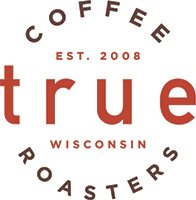Some have asked us, “What method is used on the beans we purchase?” “How much caffeine is left in the bean?” “Which chemicals are used?” “Will they harm me?” Well, put simply, removing caffeine from the coffee bean requires a solvent to bind with the caffeine molecules, which then pulls them out of the solution. Water, Ethyl Acetate, Methylene Chloride, and CO2 are the big ones. Solvents can be directly applied to the beans or indirectly applied to the liquid the beans as they soak. Either way, at least 95% of caffeine is removed, leaving maybe 5mg of caffeine in a 12-ounce cup.
Anecdotally, it seems that water-processed decafs have tasted much better over the past 10 years. For that reason, as well as to be as environmentally responsible as possible, we use only water-processed coffees at True. Furthermore, we always carry a fair-trade organic (FTO) single-origin decaf, an FTO French roast decaf, and FTO Black & Tan blend decaf. Many customers buy decaf coffee to blend with their standard non-decaffeinated choice. Give it a try and let us know what you think!
by Steve Yeazel
Anecdotally, it seems that water-processed decafs have tasted much better over the past 10 years. For that reason, as well as to be as environmentally responsible as possible, we use only water-processed coffees at True. Furthermore, we always carry a fair-trade organic (FTO) single-origin decaf, an FTO French roast decaf, and FTO Black & Tan blend decaf. Many customers buy decaf coffee to blend with their standard non-decaffeinated choice. Give it a try and let us know what you think!
by Steve Yeazel

